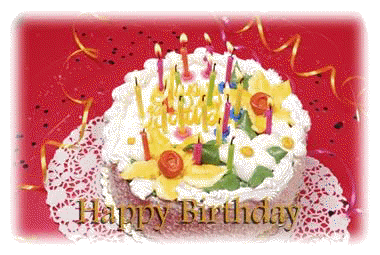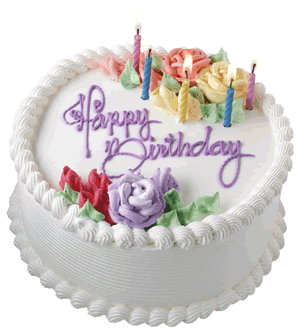Happy Birthday To You All
 It
is thought that the large-scale celebration of birthdays in Europe
began with the cult of Mithras, which originated in Persia but was
spread by soldiers throughout the Roman Empire. Before this, such
celebrations were not common; and, hence, practices from other
contexts such as the Saturnalia were adapted for birthdays. Because
many Roman soldiers took to Mithraism, it had a wide distribution
and influence throughout the empire until it was supplanted by
Christianity. The Jewish perspective on birthday celebrations is
disputed by various rabbis.
It
is thought that the large-scale celebration of birthdays in Europe
began with the cult of Mithras, which originated in Persia but was
spread by soldiers throughout the Roman Empire. Before this, such
celebrations were not common; and, hence, practices from other
contexts such as the Saturnalia were adapted for birthdays. Because
many Roman soldiers took to Mithraism, it had a wide distribution
and influence throughout the empire until it was supplanted by
Christianity. The Jewish perspective on birthday celebrations is
disputed by various rabbis.
Birthday celebrations were rare during the Middle Ages but saw a
resurgence with the advent of the Reformation. During this period,
they were seen as a good way to transfer customs from the saint's
days to other dates not linked to the newly repudiated veneration of
saints.
Even today, the celebration of birthdays is not universal in the
West; in addition to those people preferring name day celebrations,
Jehovah's Witnesses do not celebrate either, considering their
origins to be pagan festivals along with Christmas and Easter. Some
adults loathe celebrating it as it reminds them that they are
getting progressively older. And in some activities that are not
year-round, birthday acknowledgements may be discouraged because of
some birthdays not falling during the season.
In most English-speaking countries it is traditional to sing the
song Happy Birthday to You to the honored person celebrating his
birthday. The Happy Birthday Song melody is thought to be the most
frequently sung melody in the world. Similar songs exist in other
languages such as "Lang zal hij/zij leven" (and several others) in
Dutch, "Zum Geburtstag Viel Glück" in German, "Cumpleaños feliz" in
Spanish, "Sto lat" in Polish and "Tanti Auguri a te" in Italian.
This happens traditionally at a birthday party while someone brings
a birthday cake into the (often darkened) room.
 The
birthday cake is traditionally highly decorated, and typically
covered with lit candles when presented; the number of candles often
equals the age of the person. The person whose birthday it is makes
a silent wish and then blows out the candles; if done in one breath,
the wish is supposed to come true, but only if the person keeps the
wish to himself (or herself). It is also common for the "birthday
boy" or "birthday girl" to cut the initial piece of the cake as a
newlywed couple might with a wedding cake. Birthday cakes have been
a tradition dating back as far as the Middle Ages when the English
would conceal symbolic items such as gold coins, rings and thimbles
inside their cakes. Each item was associated with a prediction. For
example, a person finding a gold coin in a birthday cake would
supposedly become wealthy where a person discovering a thimble would
never marry. Typical birthday party decorations include balloons,
streamers, and confetti.
The
birthday cake is traditionally highly decorated, and typically
covered with lit candles when presented; the number of candles often
equals the age of the person. The person whose birthday it is makes
a silent wish and then blows out the candles; if done in one breath,
the wish is supposed to come true, but only if the person keeps the
wish to himself (or herself). It is also common for the "birthday
boy" or "birthday girl" to cut the initial piece of the cake as a
newlywed couple might with a wedding cake. Birthday cakes have been
a tradition dating back as far as the Middle Ages when the English
would conceal symbolic items such as gold coins, rings and thimbles
inside their cakes. Each item was associated with a prediction. For
example, a person finding a gold coin in a birthday cake would
supposedly become wealthy where a person discovering a thimble would
never marry. Typical birthday party decorations include balloons,
streamers, and confetti.
For special birthdays and for when the number of candles might be
considered impractical or a fire hazard, special candles might be
substituted for the many individual candles. These candles are in
the shape of a numeral; for example, on the fifth birthday there may
be one candle on the cake in the shape of the numeral 5, and on the
fiftieth birthday there may be two candles on the cake, one in the
shape of the numeral 5 followed by the other in the shape of the
numeral 0.
- Edith - 19th
- Tia - 8th
- Valentine - 14th
- Kat - 16th
- Connor - 11th
- Lisa - 30th
- Jonathan - 3rd
- Lynne - 5th
- Sarah - 20th
- Pat & Diane Anniversary - 12th
- Jonathan K - 29th
- Mary 26th
- Pat's Birthday - 12th
July
- Sue - 10th
- Mike De Lara - 10th
- Jacqueline - 18th
- Rita - 10th
- Puppies - 22nd
- Mickey - 24th
- Hannah - 29th
- Pete - 2nd
- Karen Sinaguglia - 10th
- J&M Anniversary - 10th
- Laurie - 12th
- Kass Anniversary - 17th
- Opal - 18th
- Zachary - 24th
- Annette (Funicello) - 24th
- Mummy - 27th
- Diane - 28th
- Cassy - 13th
- Mitch - 15th
- Jeanette - 25th
- Robin - 11th
- Otis - 12th
- Paul - 16th
- Vicky - 25th
